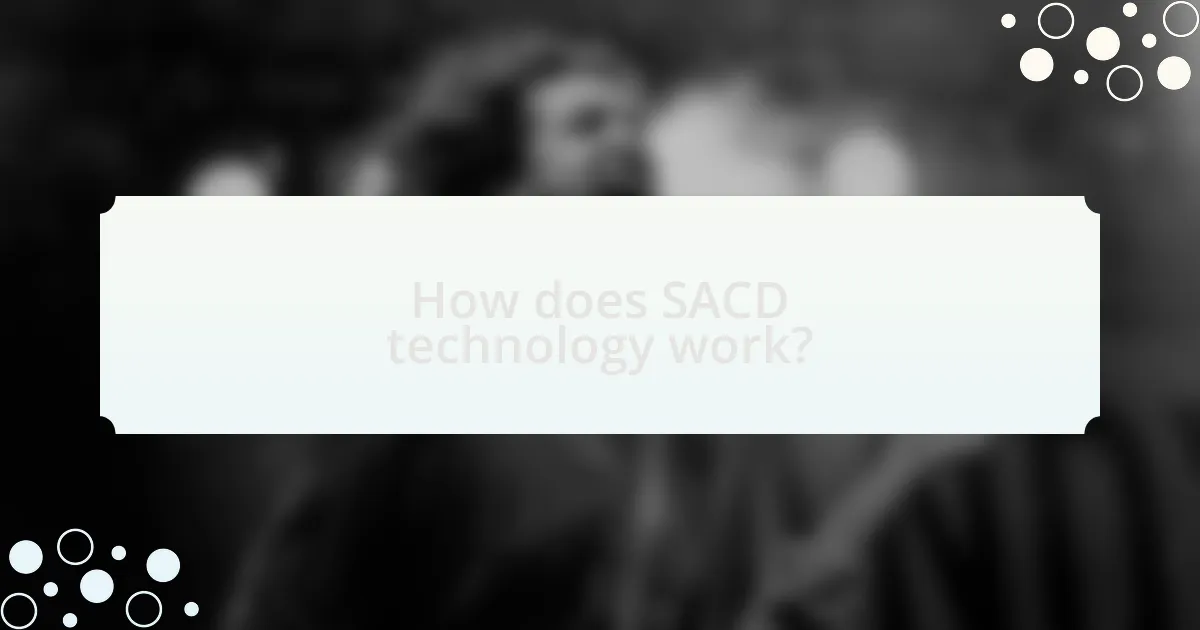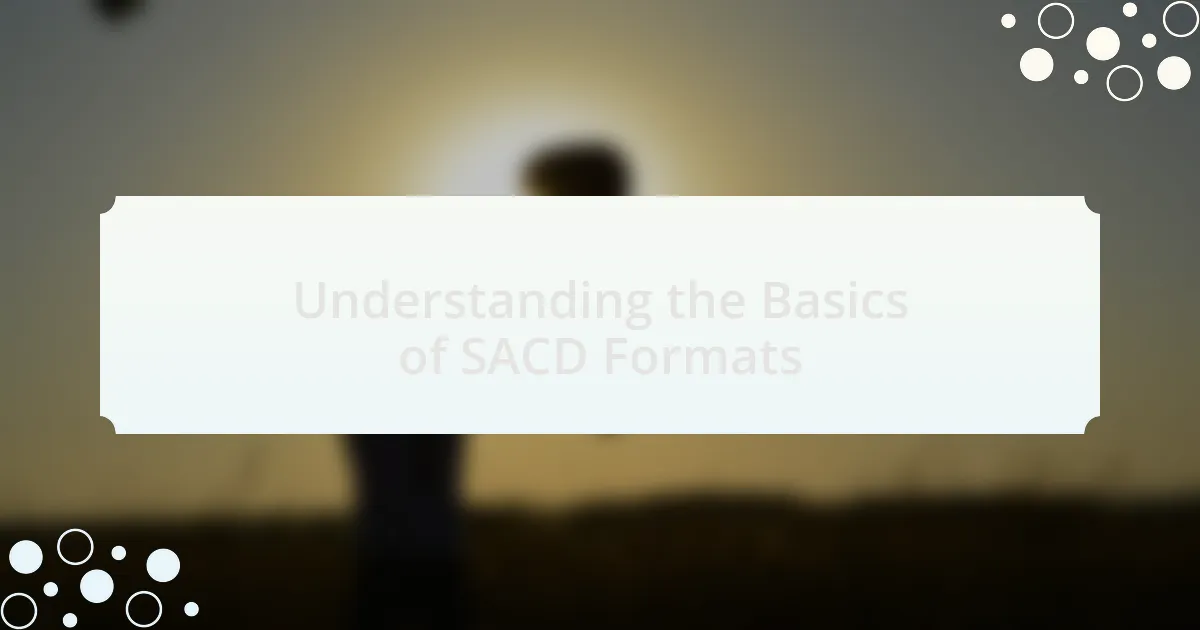SACD, or Super Audio CD, is a high-resolution audio format developed by Sony and Philips, introduced in 1999, which supports multi-channel audio and offers superior sound quality through Direct Stream Digital (DSD) technology. This article provides an overview of SACD, detailing its key features, including high-resolution audio, multi-channel capabilities, and hybrid disc formats. It also explores the differences between SACD and traditional audio formats, the advantages of using SACD, and the challenges associated with its adoption, such as compatibility issues and production costs. Additionally, the article addresses common misconceptions about SACD and offers practical tips for enhancing the listening experience.
What is SACD Format?

SACD, or Super Audio CD, is a high-resolution audio format developed by Sony and Philips, introduced in 1999. This format supports multi-channel audio and offers a higher sampling rate and bit depth compared to standard CDs, allowing for improved sound quality. SACD utilizes a technology called Direct Stream Digital (DSD), which captures audio in a way that is closer to analog sound reproduction. The format can store both high-resolution stereo and multi-channel audio tracks, making it suitable for audiophiles seeking superior listening experiences.
How does SACD differ from traditional audio formats?
SACD, or Super Audio CD, differs from traditional audio formats primarily in its ability to deliver higher audio quality through a different encoding method. Unlike standard CDs that use PCM (Pulse Code Modulation) at a 16-bit/44.1 kHz resolution, SACDs utilize DSD (Direct Stream Digital) encoding, which operates at a 1-bit/2.8224 MHz resolution. This allows SACDs to capture a broader frequency range and dynamic range, resulting in a more detailed and immersive listening experience. Additionally, SACDs can support multi-channel audio, enabling surround sound playback, which is not typically available in traditional stereo formats.
What are the key features of SACD?
The key features of SACD (Super Audio CD) include high-resolution audio, multi-channel sound capabilities, and a hybrid disc format. SACD supports audio sampling rates up to 2.8224 MHz, which is significantly higher than standard CDs, allowing for greater detail and clarity in sound reproduction. Additionally, SACD can deliver multi-channel audio, providing an immersive listening experience through formats like 5.1 surround sound. The hybrid disc format allows SACDs to be played on standard CD players, as they contain both a high-resolution layer and a standard CD layer, ensuring compatibility and accessibility for users.
Why was SACD developed?
SACD was developed to provide a higher quality audio format that surpasses the limitations of standard CDs. The introduction of SACD in 1999 by Sony and Philips aimed to deliver superior sound quality through its use of Direct Stream Digital (DSD) technology, which captures audio with greater detail and dynamic range. This development was a response to the growing demand for high-fidelity audio experiences among audiophiles and the music industry, as traditional CD formats were seen as inadequate for capturing the nuances of high-resolution recordings.
What are the types of SACD formats available?
The types of SACD formats available are Single Layer, Dual Layer, and Hybrid. Single Layer SACDs contain only the high-resolution DSD audio, while Dual Layer SACDs include both high-resolution DSD audio and a standard CD layer. Hybrid SACDs combine both formats on a single disc, allowing playback on SACD players and standard CD players. These formats cater to different playback needs and device compatibilities, ensuring a versatile listening experience.
What distinguishes hybrid SACDs from single-layer SACDs?
Hybrid SACDs are distinguished from single-layer SACDs by their dual-layer structure, which allows them to contain both a high-resolution Super Audio CD layer and a standard CD layer. This design enables hybrid SACDs to be playable on both SACD players and standard CD players, while single-layer SACDs can only be played on SACD-compatible devices. The dual-layer format of hybrid SACDs provides greater versatility and accessibility for users, as it caters to a wider range of playback options.
How do multi-channel SACDs enhance the listening experience?
Multi-channel SACDs enhance the listening experience by providing a more immersive sound environment through the use of multiple audio channels. This format allows for sound to be distributed across various speakers, creating a three-dimensional audio landscape that traditional stereo formats cannot achieve. Research indicates that listeners often perceive greater depth and clarity in music when it is presented in multi-channel formats, as it simulates a live performance setting. Additionally, multi-channel SACDs can incorporate high-resolution audio, which further improves sound fidelity and detail, making the listening experience richer and more engaging.
How does SACD technology work?

SACD technology works by utilizing a high-density optical disc format that supports both multi-channel and stereo audio playback. It employs Direct Stream Digital (DSD) encoding, which captures audio at a much higher sampling rate than standard CDs, allowing for greater detail and dynamic range. The DSD format uses a 1-bit signal sampled at 2.8224 MHz, compared to the 16-bit/44.1 kHz PCM used in CDs, resulting in a more accurate representation of the original sound. This technology enables SACDs to deliver superior audio quality, making them popular among audiophiles.
What encoding methods are used in SACD?
SACD, or Super Audio CD, primarily uses Direct Stream Digital (DSD) encoding methods. DSD is a form of pulse-density modulation that represents audio signals with a single bit at a high sampling rate, typically 2.8224 MHz, which is significantly higher than standard CD audio. This high sampling rate allows for a more accurate representation of the audio waveform, resulting in improved sound quality. The DSD encoding method is specifically designed to capture the nuances of high-resolution audio, making it a key feature of SACD technology.
How does Direct Stream Digital (DSD) contribute to sound quality?
Direct Stream Digital (DSD) enhances sound quality by utilizing a 1-bit sigma-delta modulation process that captures audio at a high sampling rate, typically 2.8 MHz or 5.6 MHz. This high sampling rate allows for a more accurate representation of the audio waveform, resulting in greater detail and clarity in sound reproduction. Research has shown that DSD’s approach minimizes quantization noise and distortion, which are common in traditional PCM formats. Consequently, listeners often perceive DSD recordings as more natural and lifelike, with improved dynamic range and spatial imaging.
What role does the SACD player play in audio playback?
The SACD player is essential for playing Super Audio CDs, which utilize a high-resolution audio format. This player decodes the DSD (Direct Stream Digital) audio signal, providing superior sound quality compared to standard CDs. SACD players support multi-channel audio, allowing for immersive listening experiences, and they can also play regular CDs, making them versatile in audio playback. The SACD format offers a sampling rate of up to 2.8 MHz, significantly higher than the 44.1 kHz of standard CDs, which enhances audio fidelity and detail.
What are the advantages of using SACD?
The advantages of using SACD (Super Audio CD) include superior audio quality, enhanced dynamic range, and multi-channel sound capabilities. SACD utilizes a higher sampling rate and bit depth compared to standard CDs, allowing for more detailed sound reproduction. Specifically, SACD employs Direct Stream Digital (DSD) encoding, which captures audio at a rate of 2.8224 MHz, significantly higher than the 44.1 kHz of standard CDs. This results in a more accurate representation of the original recording, providing listeners with a richer and more immersive audio experience. Additionally, SACD supports multi-channel audio, enabling surround sound formats that enhance the listening experience for music and film.
How does SACD improve audio fidelity compared to CDs?
SACD improves audio fidelity compared to CDs primarily through its higher sampling rate and bit depth. While CDs use a sampling rate of 44.1 kHz and a bit depth of 16 bits, SACDs utilize Direct Stream Digital (DSD) technology, which operates at a sampling rate of 2.8224 MHz and effectively provides a 1-bit resolution. This significant increase in sampling rate allows SACDs to capture a broader frequency range and more nuanced audio details, resulting in a more accurate and immersive listening experience. Additionally, SACDs support multi-channel audio, enhancing spatial sound reproduction, which is not available on standard CDs.
What are the benefits of multi-channel audio in SACD?
Multi-channel audio in SACD provides an immersive listening experience by allowing sound to come from multiple directions, enhancing spatial awareness and depth. This format enables the reproduction of music in a way that closely resembles a live performance, as it captures the nuances of instruments and vocals in a three-dimensional sound field. Additionally, multi-channel audio supports higher fidelity and dynamic range compared to traditional stereo formats, resulting in clearer and more detailed sound reproduction. Studies have shown that listeners often perceive multi-channel audio as more engaging and realistic, which can lead to a more enjoyable overall experience.
What challenges are associated with SACD formats?

SACD formats face several challenges, including limited player availability, high production costs, and compatibility issues with standard CD players. The limited number of SACD players on the market restricts consumer access, making it difficult for users to experience the format’s high-resolution audio benefits. Additionally, the production costs associated with SACD discs are higher than traditional CDs, which can deter record labels from investing in this format. Furthermore, SACDs often require specific hardware to play, leading to compatibility issues for consumers who may not own the necessary equipment, thus limiting the format’s widespread adoption.
Why has SACD not achieved widespread adoption?
SACD has not achieved widespread adoption primarily due to its limited compatibility with existing audio equipment. Unlike standard CDs, SACDs require specific players to access their high-resolution audio capabilities, which restricts their use among consumers who do not own compatible devices. Additionally, the market for high-resolution audio has remained niche, with many listeners satisfied with the quality of standard CDs or digital formats like MP3s. According to a 2020 report by the International Federation of the Phonographic Industry, only a small percentage of music sales come from high-resolution formats, indicating a lack of consumer demand for SACD.
What are the limitations of SACD in terms of compatibility?
SACD, or Super Audio CD, has significant limitations in terms of compatibility primarily due to its unique format and technology. Most standard CD players cannot play SACD discs, as they require specific hardware to decode the DSD (Direct Stream Digital) audio format used by SACDs. Additionally, while some hybrid SACDs include a standard CD layer, not all players can access the high-resolution audio layer, limiting playback options. Furthermore, many digital audio systems and streaming services do not support SACD, which restricts its use in modern audio setups. These compatibility issues hinder the widespread adoption of SACD compared to more universally accepted formats like standard CDs and digital downloads.
How does the cost of SACD impact consumer choices?
The cost of SACD significantly influences consumer choices by determining accessibility and perceived value. Higher prices may deter budget-conscious consumers, leading them to opt for more affordable formats like CDs or digital downloads. Conversely, consumers who prioritize audio quality may be willing to invest in SACDs, viewing them as superior due to their enhanced sound capabilities. Market research indicates that as of 2023, the average price of SACDs ranges from $20 to $30, which can limit the audience to audiophiles and collectors, thereby shaping purchasing decisions based on financial considerations and personal value assessments.
What are common misconceptions about SACD?
Common misconceptions about SACD include the belief that it is only a high-resolution audio format, when in fact it also supports multi-channel audio. Many people think SACD discs cannot be played on standard CD players, but hybrid SACDs contain both a standard CD layer and a high-resolution layer, allowing compatibility with regular CD players. Additionally, some assume that SACD is obsolete due to the rise of digital streaming, yet it remains popular among audiophiles for its superior sound quality. These misconceptions can lead to misunderstandings about the capabilities and relevance of SACD in modern audio consumption.
Is SACD only for audiophiles?
SACD is not only for audiophiles; it is a high-resolution audio format that can appeal to a broader audience. While audiophiles appreciate its superior sound quality due to its ability to deliver multi-channel audio and higher fidelity, SACD also offers enhanced listening experiences for casual listeners who value better sound than standard CDs. The format’s versatility in music genres and the availability of popular titles make it accessible to a wider range of consumers beyond just audiophiles.
Can SACD be played on standard CD players?
SACD cannot be played on standard CD players. SACD, or Super Audio CD, uses a different format and encoding method than standard CDs, specifically employing DSD (Direct Stream Digital) technology, which standard CD players do not support. This incompatibility means that while SACDs can be played on SACD-compatible players, they will not function in regular CD players.
What practical tips can enhance the SACD experience?
To enhance the SACD experience, ensure you use a high-quality SACD player that supports both SACD and CD formats. A dedicated SACD player optimizes audio playback, providing superior sound quality due to its advanced digital-to-analog conversion capabilities. Additionally, utilize high-fidelity audio equipment, such as quality speakers and amplifiers, to fully appreciate the enhanced audio resolution that SACDs offer. Proper speaker placement and room acoustics also play a crucial role in sound quality; positioning speakers correctly can significantly improve the listening experience. Lastly, select well-mastered SACD titles, as the quality of the recording directly impacts the overall sound experience.
How can one set up a home audio system for optimal SACD playback?
To set up a home audio system for optimal SACD playback, one should use a dedicated SACD player connected to a high-quality audio receiver or amplifier that supports multi-channel audio. This setup ensures that the high-resolution audio formats of SACD, which can include stereo and multi-channel sound, are accurately reproduced.
Additionally, using high-quality speakers that can handle the frequency range of SACD recordings will enhance the listening experience. For the best results, connect the SACD player via HDMI or analog outputs to preserve audio quality, as these connections can transmit the high-resolution audio signals effectively.
Research indicates that SACD’s DSD (Direct Stream Digital) format provides superior sound quality compared to standard CDs, making the choice of equipment crucial for optimal playback.
What should consumers consider when purchasing SACDs?
Consumers should consider the audio quality, compatibility, and selection of titles when purchasing SACDs. The audio quality of SACDs is superior due to their high-resolution format, which can provide a more immersive listening experience compared to standard CDs. Compatibility is crucial, as not all players support SACD formats; consumers should ensure their equipment can play SACDs, particularly if they are investing in a high-end audio system. Additionally, the selection of titles available on SACD can be limited compared to other formats, so consumers should verify that the music they want is available in SACD format before making a purchase.

Leave a Reply